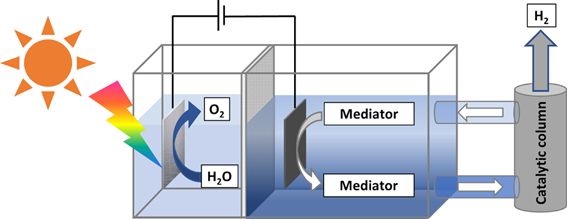Images of climate innovation
Hydrogen production driven by sunlight
Imagine making zero-carbon fuels directly from water using the power of the Sun. Our research aims to do just that, using sunlight as the energy source to split water into hydrogen and oxygen. This could lead to clean, green, sustainable and accessible energy for everyone.

As our reliance on renewable energy sources grows, so too does our need to store this energy to mitigate against troughs in supply. The electrolysis of water to generate hydrogen and oxygen is one of the most promising ways in which to harness intermittent renewable power sources and store the energy that these provide as a clean-burning and sustainable fuel (hydrogen).
Here at the University of Glasgow, we are working on new and revolutionary types of electrolyser that allow the energy of the sun to be used directly to generate pure hydrogen from water. This hydrogen could then be used in fuel cells, releasing energy and re-generating water, with no other side-products. Such technology will be vital in securing a transition to a more sustainable, zero-carbon energy system.
Our decoupled electrolysis approach (see illustration and https://science.sciencemag.org/content/345/6202/1326) allows the efficient generation of pure hydrogen and pure oxygen directly from renewable power inputs, without the need for extensive product purification. Decoupled electrolysis systems such as these could allow surplus renewable energy from solar panels and wind turbines to be used to form the storable fuel, hydrogen.
Alternatively, sunlight could be used directly to generate hydrogen from water in an 'artificial leaf' a device that stores solar power directly as chemical fuels (as shown in the illustration).
Entrant: Mark Symes , University of Glasgow
Copyright: Mark Symes
Funding: Engineering and Physical Sciences Research Council (EPSRC) and the Royal Society.
Collaborators: Leroy Cronin (University of Glasgow), Renata Solarska (University of Warsaw), Pawel Kulesza (University of Warsaw).